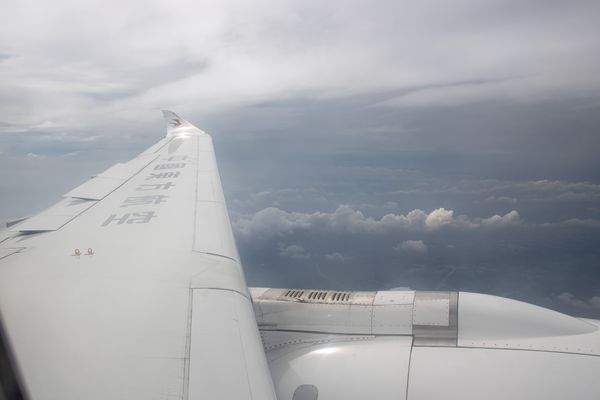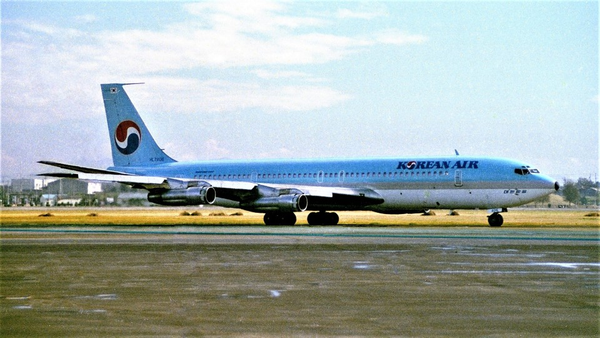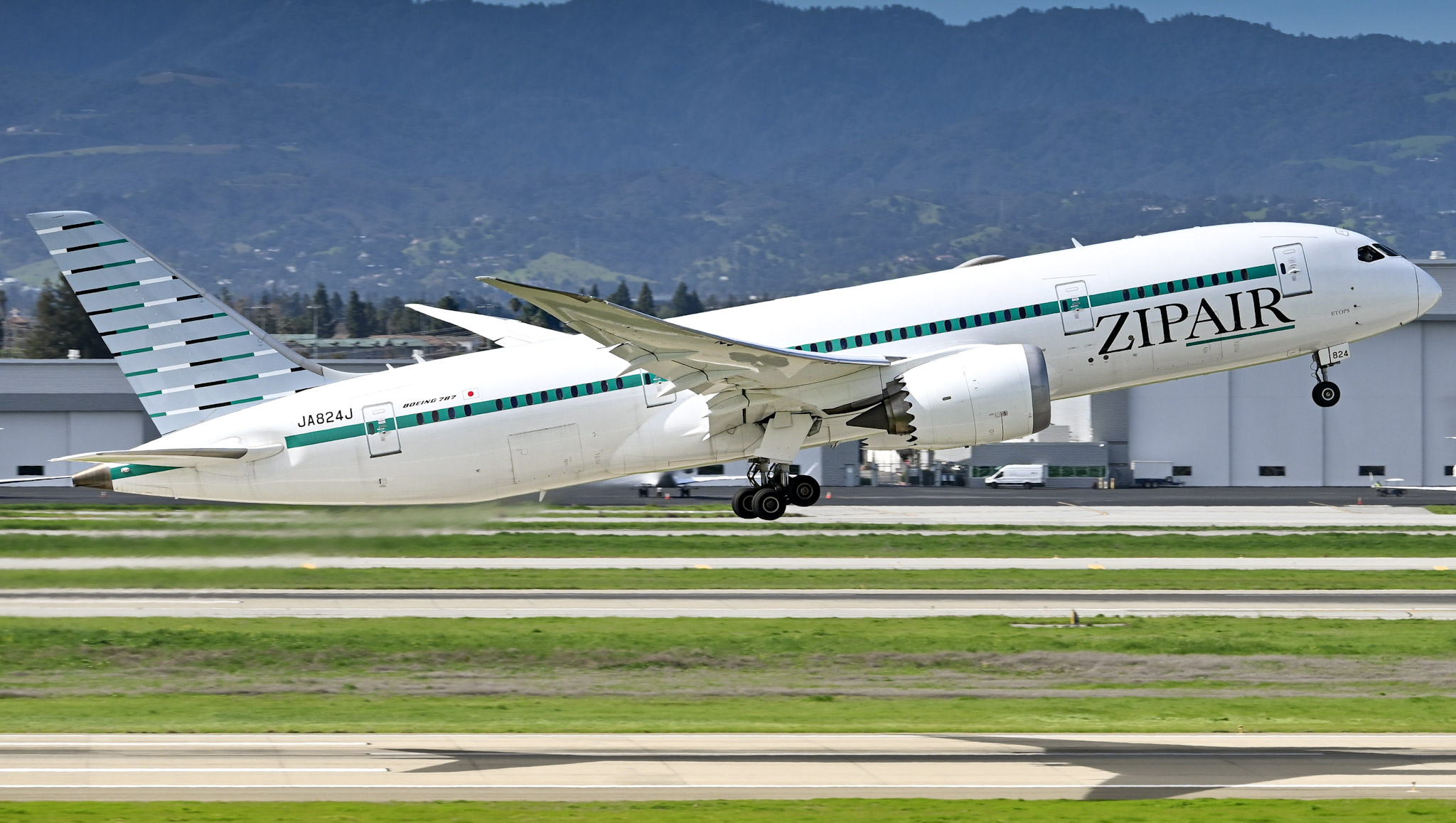ZIPAIR Tokyo, established in 2018 as a subsidiary of Japan Airlines (JAL), operates as a low-cost carrier (LCC) specializing in long-haul international routes. The airline's business model focuses on providing affordable air travel by implementing cost-saving measures and offering optional services for additional fees.
A Lean, No-Frills Business Model
As an LCC, ZIPAIR minimizes operational costs by utilizing a simplified service model. The airline operates a fleet of eight Boeing 787-8 Dreamliners, which it leases from parent company Japan Airlines. The aircraft are known for their fuel efficiency and are designed for long-haul routes, reducing operational costs per passenger mile compared to older, less efficient planes.

Moreover, ZipAir maximizes revenue with a high-density cabin layout. Each Boeing 787-8 in its fleet is configured with 290 seats, including 18 lie-flat "Zip Full-Flat" seats in a premium cabin (1-2-1 layout) and 272 standard economy seats (3-3-3 layout). It also offers free internet connectivity to all passengers via the aircraft’s satellite link. This helps the airline reduce costs by forgoing traditional in-flight entertainment systems and complimentary services, instead offering free Wi-Fi and encouraging passengers to use their own devices for entertainment.
To maintain low base fares, ZIPAIR offers optional add-ons such as in-flight meals, seat selection, and checked baggage. This allows passengers to customize their travel experience based on their preferences and budget. This unbundled pricing strategy enables travelers to pay only for the services they require, contributing to the airline's affordability. For example, a checked bag up to 50 pounds on a U.S.-Tokyo route costs $59, while a hot meal might set you back $15–20—still far cheaper than the bundled amenities of full-service airlines.

ZipAir’s route network is carefully curated to balance demand with cost efficiency. It focuses on high-traffic leisure and business corridors, like Tokyo to Honolulu, Los Angeles, San Francisco — and the newly-launched Houston on March 4, 2025 — where it can compete with legacy carriers on price. To drum up early interest for the new route, ZIPAIR offered promotional fares from Houston to Tokyo starting at $333 one-way, compared to the regular fare to be offered on the route, which is expected to be around $450 each way.
The new service between NRT and IAH is ZIPAIR’s fifth trans-pacific destination after Los Angeles, San Francisco, San Jose, and Vancouver. The airline also serves Honolulu in Hawaii, as well as several Asian cities. Off-peak flights can drop as low as $91 for kids under six or $325 for adults, making it a lifeline for budget-conscious families and solo travelers during a time when legacy carrier fares often soar past $1,000 round-trip.
In addition, the airline has achieved a 7/7 safety rating from AirlineRatings.com, indicating compliance with international safety standards and a strong safety record.

In terms of customer experiences with ZIPAIR, there are mixed feelings from passengers reflecting the airline's low-cost model. Flights are point-to-point, with no codeshares or interline agreements, so connections depend on passengers' independent planning. Customer service can be sparse, and flexibility is limited: changes within seven days of departure forfeit most of their fare. Yet, for those who pack light, plan ahead, and prioritize price over pampering, the savings are hard to beat.
Top 5 Unique Gifts for Pilots & Aviation Lovers Under $50 » Memphis at Midnight: Inside FedEx's Global Superhub » Cities in the Sky: The Future Built on eVTOL Flight »
Comments (0)
Add Your Comment
TAGS
INFORMATIONAL Zipair TokyoLong-HaulLow-costAirlinesB787JapanTravelMore than just headlines.
Get unlimited ad-free access to in-depth aviation news, premium stories, and exclusive insights other sites don't cover.
- Ad-free browsing on AeroXplorer
- Unlimited access to premium and exclusive articles
- Higher photo upload limits & commissions on sales
- Digital access to Jetstream Magazine on higher tiers
- Ad-free browsing
- Sell aviation photos with 60% commission
- First week free!
- Everything in Basic+
- Unlimited premium articles
- Sell aviation photos with 70% commission
- Free Digital subscription to Jetstream Magazine
- First week free!
- Everything in Basic+ and Pro
- Sell aviaiton photos with 80% commission
- Early access to exclusive stories
- Free Digital+Print subscription to Jetstream Magazine
RECENTLY PUBLISHED
 VIDEO: What It's Like Onboard China's COMAC C919
We flew onboard China Eastern's COMAC C919 to experience China's homegrown narrow-body up close. From seat comfort to cabin layout to noise levels to tech: how does it really compare with the Boeing 737 and Airbus A320? This review puts all three workhorses under the same spotlight.
TRIP REPORTS
READ MORE »
VIDEO: What It's Like Onboard China's COMAC C919
We flew onboard China Eastern's COMAC C919 to experience China's homegrown narrow-body up close. From seat comfort to cabin layout to noise levels to tech: how does it really compare with the Boeing 737 and Airbus A320? This review puts all three workhorses under the same spotlight.
TRIP REPORTS
READ MORE »
 KAL858: The North Korean Bombing that Shocked the World
Among the 99 passengers boarding Korean Air Flight 858 on November 29, 1987, few could imagine their journey would end as one of aviation's darkest mysteries.
STORIES
READ MORE »
KAL858: The North Korean Bombing that Shocked the World
Among the 99 passengers boarding Korean Air Flight 858 on November 29, 1987, few could imagine their journey would end as one of aviation's darkest mysteries.
STORIES
READ MORE »
 Ghost Networks: The Rise, Fall, and Revival of Fifth-Freedom Flights
Fifth-freedom flights — routes where an airline flies between two countries outside its home base — have always lived in aviation's twilight zone. We chart their rise, their near-disappearance, and the surprising markets where they still thrive today. Then we take you on board a special Seoul-Tokyo fifth-freedom flight to show how the experience stacks up against a typical regional carrier.
TRIP REPORTS
READ MORE »
Ghost Networks: The Rise, Fall, and Revival of Fifth-Freedom Flights
Fifth-freedom flights — routes where an airline flies between two countries outside its home base — have always lived in aviation's twilight zone. We chart their rise, their near-disappearance, and the surprising markets where they still thrive today. Then we take you on board a special Seoul-Tokyo fifth-freedom flight to show how the experience stacks up against a typical regional carrier.
TRIP REPORTS
READ MORE »


